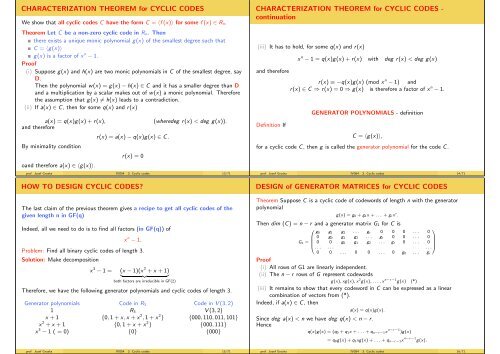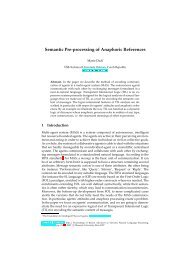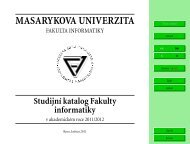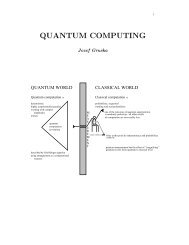2×2 handouts
2×2 handouts
2×2 handouts
You also want an ePaper? Increase the reach of your titles
YUMPU automatically turns print PDFs into web optimized ePapers that Google loves.
CHARACTERIZATION THEOREM for CYCLIC CODES<br />
We show that all cyclic codes C have the form C = 〈f (x)〉 for some f (x) ∈ R n .<br />
Theorem Let C be a non-zero cyclic code in R n . Then<br />
there exists a unique monic polynomial g(x) of the smallest degree such that<br />
C = 〈g(x)〉<br />
g(x) is a factor of x n − 1.<br />
Proof<br />
(i) Suppose g(x) and h(x) are two monic polynomials in C of the smallest degree, say<br />
D.<br />
Then the polynomial w(x) = g(x) − h(x) ∈ C and it has a smaller degree than D<br />
and a multiplication by a scalar makes out of w(x) a monic polynomial. Therefore<br />
the assumption that g(x) ≠ h(x) leads to a contradiction.<br />
(ii) If a(x) ∈ C, then for some q(x) and r(x)<br />
a(x) = q(x)g(x) + r(x),<br />
and therefore<br />
By minimality condition<br />
oand therefore a(x) ∈ 〈g(x)〉.<br />
r(x) = a(x) − q(x)g(x) ∈ C.<br />
r(x) = 0<br />
(wheredeg r(x) < deg g(x)).<br />
prof. Jozef Gruska IV054 3. Cyclic codes 13/71<br />
HOW TO DESIGN CYCLIC CODES?<br />
The last claim of the previous theorem gives a recipe to get all cyclic codes of the<br />
given length n in GF(q)<br />
Indeed, all we need to do is to find all factors (in GF(q)) of<br />
x n − 1.<br />
Problem: Find all binary cyclic codes of length 3.<br />
Solution: Make decomposition<br />
x 3 − 1 = (x − 1)(x 2 + x + 1)<br />
| {z }<br />
both factors are irreducible in GF(2)<br />
Therefore, we have the following generator polynomials and cyclic codes of length 3.<br />
Generator polynomials<br />
1<br />
x + 1<br />
x 2 + x + 1<br />
x 3 − 1 ( = 0)<br />
Code in R 3<br />
R 3<br />
{0, 1 + x, x + x 2 , 1 + x 2 }<br />
{0, 1 + x + x 2 }<br />
{0}<br />
Code in V (3, 2)<br />
V (3, 2)<br />
{000, 110, 011, 101}<br />
{000, 111}<br />
{000}<br />
CHARACTERIZATION THEOREM for CYCLIC CODES -<br />
continuation<br />
(iii) It has to hold, for some q(x) and r(x)<br />
and therefore<br />
Definition If<br />
x n − 1 = q(x)g(x) + r(x) with deg r(x) < deg g(x)<br />
r(x) ≡ −q(x)g(x) (mod x n − 1) and<br />
r(x) ∈ C ⇒ r(x) = 0 ⇒ g(x) is therefore a factor of x n − 1.<br />
GENERATOR POLYNOMIALS - definition<br />
C = 〈g(x)〉,<br />
for a cyclic code C, then g is called the generator polynomial for the code C.<br />
prof. Jozef Gruska IV054 3. Cyclic codes 14/71<br />
DESIGN of GENERATOR MATRICES for CYCLIC CODES<br />
Theorem Suppose C is a cyclic code of codewords of length n with the generator<br />
polynomial<br />
g(x) = g 0 + g 1 x + . . . + g r x r .<br />
Then dim (C) = n − r and a generator matrix G 1 for C is<br />
0<br />
1<br />
g 0 g 1 g 2 . . . g r 0 0 0 . . . 0<br />
0 g 0 g 1 g 2 . . . g r 0 0 . . . 0<br />
G 1 = B 0 0 g 0 g 1 g 2 . . . g r 0 . . . 0 C<br />
@<br />
. . . . . . . . .<br />
A<br />
0 0 . . . 0 0 . . . 0 g 0 . . . g r<br />
Proof<br />
(i) All rows of G1 are linearly independent.<br />
(ii) The n − r rows of G represent codewords<br />
g(x), xg(x), x 2 g(x), . . . , x n−r−1 g(x) (*)<br />
(iii) It remains to show that every codeword in C can be expressed as a linear<br />
combination of vectors from (*).<br />
Indeed, if a(x) ∈ C, then<br />
a(x) = q(x)g(x).<br />
Since deg a(x) < n we have deg q(x) < n − r.<br />
Hence<br />
q(x)g(x) = (q 0 + q 1 x + . . . + q n−r−1 x n−r−1 )g(x)<br />
= q 0 g(x) + q 1 xg(x) + . . . + q n−r−1 x n−r−1 g(x).<br />
prof. Jozef Gruska IV054 3. Cyclic codes 15/71<br />
prof. Jozef Gruska IV054 3. Cyclic codes 16/71















